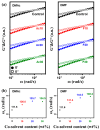Cellulose Fiber with Enhanced Mechanical Properties: The Role of Co-Solvents in Gel-like NMMO System
- PMID: 39330209
- PMCID: PMC11430876
- DOI: 10.3390/gels10090607
Cellulose Fiber with Enhanced Mechanical Properties: The Role of Co-Solvents in Gel-like NMMO System
Abstract
Cellulose has garnered attention in the textile industry, but it exhibits limitations in applications that require high strength and modulus. In this study, regenerated cellulose fiber with enhanced mechanical properties was fabricated from a gel-like N-methylmorpholine N-oxide (NMMO)-cellulose solution by modulating the intermolecular interaction and conformation of the cellulose chains. To control the interaction, two types of co-solvents (dimethyl acetamide (DMAc) and dimethyl formamide (DMF)) were added to the cellulose solutions at varying concentrations (10, 20, and 30 wt%). Rheological analysis showed that the co-solvents reduced the solution viscosity by weakening intermolecular interactions. The calculated distance parameter (Ra) in Hansen space confirmed that the co-solvent disrupted intermolecular hydrogen bonding within cellulose chains. The solutions were spun into fiber via a simple wet spinning process and were characterized by X-ray diffraction (XRD) and universal testing machine (UTM). The addition of co-solvent led to an increased crystallinity index (C.I.) owing to the extended cellulose chains. The modulus of the resulting fiber was increased when the co-solvent concentration was 10 wt%, regardless of the co-solvent type. This study demonstrates the potential for enhancing the mechanical properties of cellulose-based products by modulating the conformation and interaction of cellulose chains through the addition of co-solvent.
Keywords: N-methylmorpholine N-oxide; cellulose; co-solvent; conformation; fiber; gel-like solution; mechanical property; rheology.
Conflict of interest statement
The authors declare no conflicts of interest.
Figures







Similar articles
-
Development of Cellulose Microfibers from Mixed Solutions of PAN-Cellulose in N-Methylmorpholine-N-Oxide.Polymers (Basel). 2024 Jun 30;16(13):1869. doi: 10.3390/polym16131869. Polymers (Basel). 2024. PMID: 39000724 Free PMC article.
-
Effect of Water Content in N-Methylmorpholine N-Oxide/Cellulose Solutions on Thermodynamics, Structure, and Hydrogen Bonding.J Phys Chem B. 2015 Dec 3;119(48):15014-22. doi: 10.1021/acs.jpcb.5b07500. Epub 2015 Nov 20. J Phys Chem B. 2015. PMID: 26545042
-
Regenerated cellulose-silk fibroin blends fibers.Int J Biol Macromol. 2008 Aug 15;43(2):106-14. doi: 10.1016/j.ijbiomac.2008.03.009. Epub 2008 Apr 11. Int J Biol Macromol. 2008. PMID: 18513793
-
Luminescent Cellulose Fibers Modified with Poly((9-Carbazolyl)Methylthiirane).Polymers (Basel). 2020 Oct 7;12(10):2296. doi: 10.3390/polym12102296. Polymers (Basel). 2020. PMID: 33036466 Free PMC article.
-
Utilization of Cellulose to Its Full Potential: A Review on Cellulose Dissolution, Regeneration, and Applications.Polymers (Basel). 2021 Dec 12;13(24):4344. doi: 10.3390/polym13244344. Polymers (Basel). 2021. PMID: 34960895 Free PMC article. Review.
Cited by
-
Influence of Starch Cross-Linking on the Performance of Cellulose Aerogels for Oil Spills Sorption.Gels. 2025 May 24;11(6):386. doi: 10.3390/gels11060386. Gels. 2025. PMID: 40558685 Free PMC article.
References
Grants and funding
LinkOut - more resources
Full Text Sources

